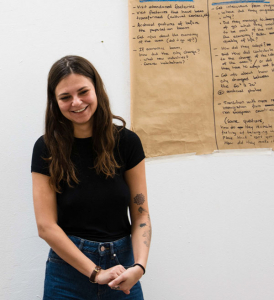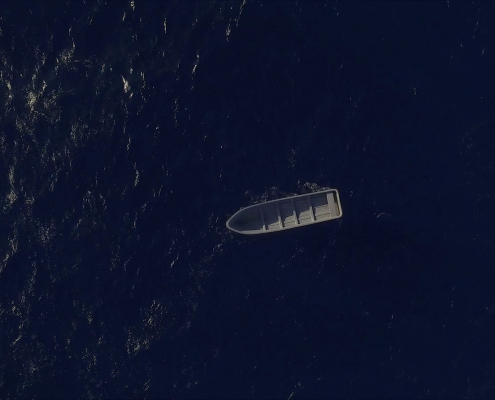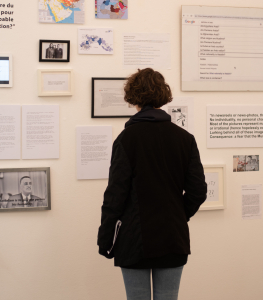Being external tutor at Metàfora
The advanced level students at Metàfora’s Studio Arts Programs spend their last year concentrating on their personal art investigation and discourse. During the last months of their stay we look for suitable external tutors for each of them. The external tutor supplements the work of the in-house-tutor who already works with the student.
The external tutor is most often an artist, curator or cultural agent from the local or international context, and his/her role is to give the student fresh input during the concluding phase of the work. Metàfora looks for different professionals who share affinities with the investigation of the student.
In the case of 3rd year student Layal Nakle, the choice was clear: Hiuwai Chu shares many of Layal’s concerns about Pan Arab identity and archives of identity.
Hiuwai Chu is curator of exhibitions at MACBA, Museu d’Art Contemporani de Barcelona since 2016, and was assistant curator since 2007. Prior to moving to Barcelona, she was an associate editor at the Aperture Foundation in New York. She also worked at Art Horizons, where as Project Director she created educational arts programs and itineraries for clients such as museums. Hiuwai has a degree in Anthropology from Barnard College, Columbia University.
In 2017, Hiuwai co-curated the exhibition project “Against Photography. An Annotated History of the Arab Image Foundation” and this project lead her to Beirut in several occasions. Most recently she has curated an important show at the MACBA “Undefined Territories; Perspectives on Colonial Legacies”, an exhibition which talks about the postcolonial condition of many nations and the crisis, difficulties and challenges which accompany them in their fight for voices.
Layal Nakle Layal Nakle is a Lebano-Belgian research artist graduating student on Metàfora’s Advanced Diploma in Studio Arts this year. Layal was born on the Ivory Coast and having been exposed to many cultures, she is interested in the different forms of identity and their relation to current power structures. She investigates the dialogues about identity, mobility and conflict that sporadically happen between the West and the rest of the world.
Layal’s practice first revolves around researching and collecting data. After gathering all the materials, she maps it on to a wall before translating it into an artistic language that renders her questionings into poetical assemblages. These assemblages use semiology and symbolism to contradict the austerity of conventional academic ways of sharing researches’ results.
With echoes from a background in cinema and photography, Layal creates wide installations that enhances the purpose or capability of each medium in the act of (hi)story telling; pushing forward the limitation of a single format. She explores new ways to construct narratives. She appropriates personal stories to apply them to wider issues; rendering individual conflicts into collective problematics. Her work often oscillates between politics and poetry; between stories and history.
Hiuwai speaking to a group of Metàfora students
How has the tutoring experience been? Have you tutored aspiring artists before?
The experience of being an external tutor at Metàfora has been very rewarding. As a curator at the MACBA, most of my encounters and exchanges are with more established artists who have been working in the field for many years, so it has been refreshing to engage in a continuous dialogue with a young artist who is starting out and still searching for a framework and visual language to articulate her ideas and interests.
In the past, I have done studio visits with artists from the Sala d’Art Jove program, which is something that my colleagues at the museum and I are continuing to participate in. In this case, it is only one studio visit, but I always make myself available if the artists want to maintain contact.
We always like to look for an adequate external tutor for each student, someone who shares interest in his/her investigation. How does Layal’s work relate your professional experience?
I believe I was asked to be Layal’s tutor because I worked on the exhibition Against Photography. An Annotated History of the Arab Image Foundation by Akram Zaatari. This project involved over 2 years of research, conversation and collaboration with the artist, including research trips to Beirut (and getting to know the local scene along the way). I also have a background in anthropology and photography which are both related to Layal’s practice.
Superflex, Still image from the film ‘Kwassa Kwassa’, 2015
This piece forms part of “Undefined Territories; Perspectives on Colonial Legacies“, currently on show at MACBA
Image from Layal’s work at the recent exhibition “Flexure” at Àngels barcelona, Espai 2.
Where – and doing what – do you envision Layal in the future?
I think Layal’s work has great potential. It addresses very relevant to issues in our society today, especially with the current backdrop of an increasing prejudice towards the Arab and Islamic worlds. Her exploration of Arab identity by the questioning of the meaning of the term Arab through both first-hand sources and the internet brings forth voices of a new generation that very much need to be heard. I definitely see Layal continuing her research-based practice to address such personal questions that also have valuable meaning within a broader context. Perhaps a constructive next step would be to apply to a good artist residency where she can further develop her practice and foster fruitful exchanges between both peers and professionals.







